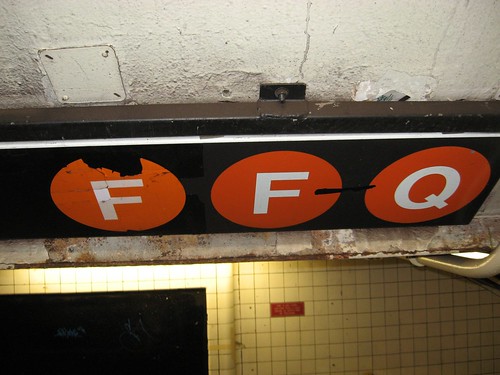 Over the last few months, the Department of Transportation has engaged in a series of initiatives to make New York City’s streets more pedestrian- and biker-friendly. They’ve put in a nifty bike lane on Ninth Ave. and are currently spearheading a much-needed renovation of the Grand Army Plaza disaster. But I have to wonder if their latest initiative — directional compasses on the sidewalks at the top of four subway station exits — might just be overkill.
Over the last few months, the Department of Transportation has engaged in a series of initiatives to make New York City’s streets more pedestrian- and biker-friendly. They’ve put in a nifty bike lane on Ninth Ave. and are currently spearheading a much-needed renovation of the Grand Army Plaza disaster. But I have to wonder if their latest initiative — directional compasses on the sidewalks at the top of four subway station exits — might just be overkill.
Here’s the story: Last year, a 71-year-old New York native who has somehow never been able to figure out his way around the easy grid of Manhattan suggested in this piece in The Times that every subway staircase be equipped with a directional compass. These compasses ideally would point the way to the nearest avenues and give emerging straphangers an idea of north-south-east-west (or at least as the cardinal directions apply to Manhattan). So DOT decided to give it a go. No longer would New Yorkers be bombarded by lost folks wanting to know which way Eighth Avenue is.
James Barron of The Times has more in this story:
Now the city is experimenting with a new way to help people go where they want to go without wasting more steps than they have to. The city and the private business improvement district for the neighborhood around Grand Central Terminal have installed compass-shaped decals on sidewalks, right where riders emerge from heavily used subway stairwells.
The gold-on-black decals are 24 inches in diameter, larger than a large pizza but smaller than a manhole cover. They carry two kinds of information: directions for north, east, south and west, and the names of the nearest streets.
The four test pilots in this program went up — or is that down? — yesterday. One sits on 42nd St. between Lexington and Third Aves.; one on Lex between 42nd and 43rd; one on 51st between Lex and Park; and one on 53rd between Madison and Park. But I have to wonder if these are really necessary.
Nitpickingly, the compasses are mislabeled. In the minds of New Yorkers, uptown in Manhattan is north and the Hudson River is always to the west. But in reality — if you include, you know, the rest of the world — uptown is northeast and, while you would reach the Hudson River by heading due west, numbered streets are at northwest-southeast bent instead of a true east-west alignment. Small beans, I know. But it’s a little wrong.
But more on my mind is the question posed by Cityroom: “Was this really a pressing problem in need of a solution? Much of the city is on a grid, after all — even Queens addresses follow a certain logic.” Brad Allen at Streetsblog admits to being directionally-challenged, but the worst that happens in this city is that someone ends up one block in the wrong direction. And now with these compasses right at the top of subway entrances, confused tourists will stop in the worst possible place: at the top of a crowded staircase. I can’t wait.
If you live in New York, you should know which avenues run uptown and downtown. You should know which streets run toward the Hudson (odds) and which ones run toward the East River (evens). I can see a need for these signs in the odd nooks and crannies of Lower Manhattan, Chinatown and the Village, but it’s nearly impossible to get lost in Midtown. Now, we have ugly giant compasses marring the sidewalk. It seems that DOT is trying to solve a problem that just isn’t that bad.
While I might be too harsh on this compasses, I’m not alone. Anna Medina, quoted in Barron’s Times article, summed it up nicely. “Personally, I wouldn’t use it because I’m from New York and I know where I’m going,” she said. “When you’re from New York, everyone knows where you’re going.”





